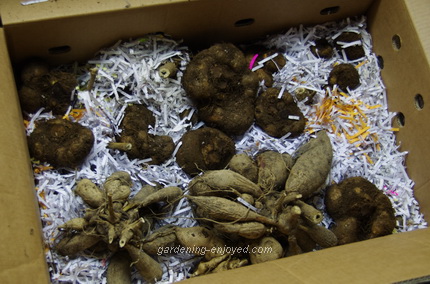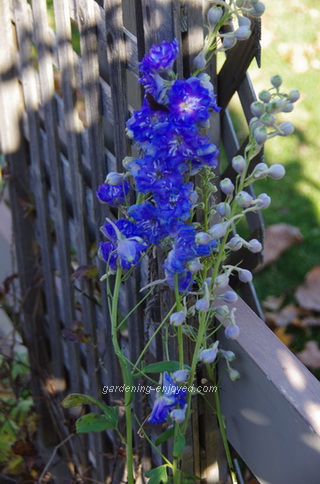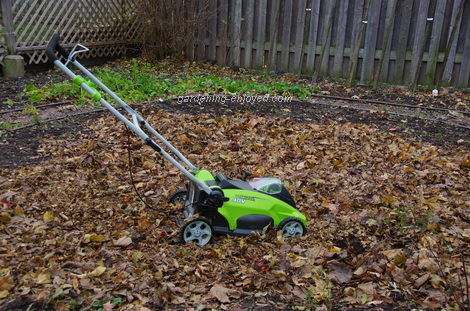| Back to Back Issues Page |
 |
|
Dallying In The Dirt, Issue #240--- Those autumn leaves are garden gold. November 14, 2015 |
 It was always my intention to use it for mulch in the vegetable garden but we all know what often happens to good intentions. In the upstairs office we have a paper shredder. In an attempt to thwart the identity thieves, anything that goes toward the recycle box will have our name and address removed and shredded. Just occasionally the Assistant Gardener, and maybe even myself, will print something that is not exactly what we intended and it also has personal identification on it and then it makes it through the shredder as well. This creates the large bag of shredded paper that was going to be used as mulch. You can see from the picture that I have developed a much better, and easier to do, use for all of that material. The carefully dried and cleaned tubers from the Tuberous Begonias the similarly treated Dahlias and the Colocasias are nestled into the shredded paper and tucked into a large
box. That box arrived with the Tulip bulbs in it and therefore it is quite sturdy and has air holes already punched out of it. When all of the bulbs are dried and packed it will find a spot in a cool corner of the basement to spend the months until their resurrection in early March. They will not make it into the cold room as it often gets much too cold to keep those tubers happy. Boxes and paper get recycled, identity theft is hopefully avoided and a garden of beauty is preserved for next year.
It was always my intention to use it for mulch in the vegetable garden but we all know what often happens to good intentions. In the upstairs office we have a paper shredder. In an attempt to thwart the identity thieves, anything that goes toward the recycle box will have our name and address removed and shredded. Just occasionally the Assistant Gardener, and maybe even myself, will print something that is not exactly what we intended and it also has personal identification on it and then it makes it through the shredder as well. This creates the large bag of shredded paper that was going to be used as mulch. You can see from the picture that I have developed a much better, and easier to do, use for all of that material. The carefully dried and cleaned tubers from the Tuberous Begonias the similarly treated Dahlias and the Colocasias are nestled into the shredded paper and tucked into a large
box. That box arrived with the Tulip bulbs in it and therefore it is quite sturdy and has air holes already punched out of it. When all of the bulbs are dried and packed it will find a spot in a cool corner of the basement to spend the months until their resurrection in early March. They will not make it into the cold room as it often gets much too cold to keep those tubers happy. Boxes and paper get recycled, identity theft is hopefully avoided and a garden of beauty is preserved for next year. This wonderful warm November continues to yield little delights all over the garden. This beautiful blast of blue is a November blooming bunch of Delphiniums. They certainly aren’t as tall and showy as the mid summer bloom but they are in November. When I was cleaning up that bed, I noticed these stalks with their promising array of flower buds so I left them, never believing that the weather would hold long enough to let them develop but there they are. Now if they were adjacent to the bright yellow Iris that is blooming in the back yard, I could pretend that I had actually done some careful colour planning when they were planted but nobody would ever believe me. They were promising freezing temperatures last night so I cut that Iris and brought it in and it seems to be opening up. The beautiful Delphinium was left to fend for itself and it still looks pretty good this morning. I know it did get cold because the grandsons, that live just to the north, were
asking why there was snow on their deck but not on the grass in the meadow. Their mother was trying to explain, while wondering why the cushions, that she had put away for the winter, were also on the deck covered in snow. Something about fort building was muttered.
This wonderful warm November continues to yield little delights all over the garden. This beautiful blast of blue is a November blooming bunch of Delphiniums. They certainly aren’t as tall and showy as the mid summer bloom but they are in November. When I was cleaning up that bed, I noticed these stalks with their promising array of flower buds so I left them, never believing that the weather would hold long enough to let them develop but there they are. Now if they were adjacent to the bright yellow Iris that is blooming in the back yard, I could pretend that I had actually done some careful colour planning when they were planted but nobody would ever believe me. They were promising freezing temperatures last night so I cut that Iris and brought it in and it seems to be opening up. The beautiful Delphinium was left to fend for itself and it still looks pretty good this morning. I know it did get cold because the grandsons, that live just to the north, were
asking why there was snow on their deck but not on the grass in the meadow. Their mother was trying to explain, while wondering why the cushions, that she had put away for the winter, were also on the deck covered in snow. Something about fort building was muttered.Now it’s time to answer a few of my reader’s questions. Don’t forget to check the front page of the Website for frequent short ideas for current gardening activities. Joan Asks? We appear to have raccoons digging up our lawn the last couple of weeks. One night it is the front yard, the next night the back yard. My usually patient husband is starting to get very annoyed with patching up the lawn each morning. They must be looking for grubs which I thought they usually looked for in the early spring. I am trying to make light of it for now & tell my husband that the raccoons are aerating the lawn for us. We
know we will need to do some reseeding in the spring and top-dressing with compost. Is there anything we can do NOW to deter them? |
| Back to Back Issues Page |
